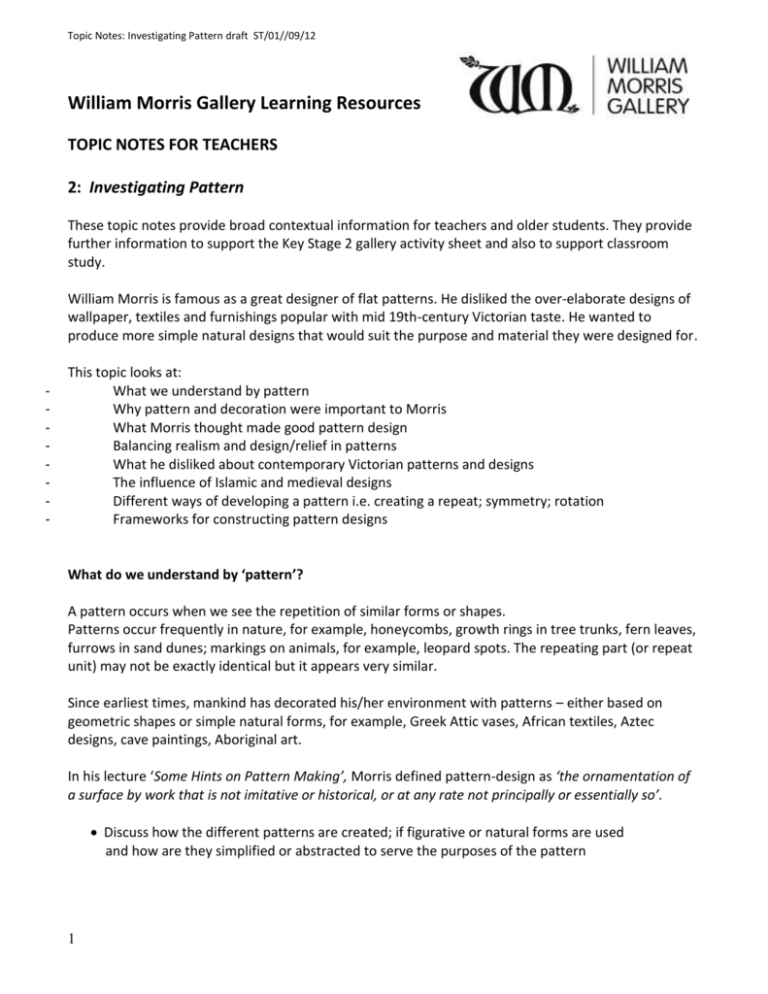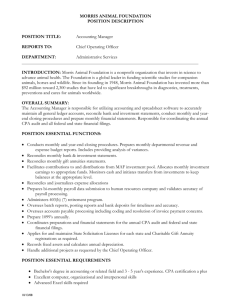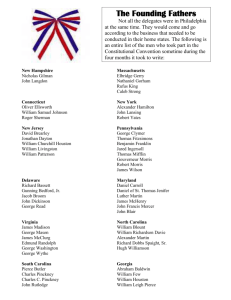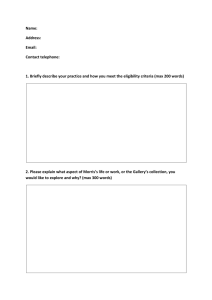Topic 2 Investigating Patterns
advertisement

Topic Notes: Investigating Pattern draft ST/01//09/12 William Morris Gallery Learning Resources TOPIC NOTES FOR TEACHERS 2: Investigating Pattern These topic notes provide broad contextual information for teachers and older students. They provide further information to support the Key Stage 2 gallery activity sheet and also to support classroom study. William Morris is famous as a great designer of flat patterns. He disliked the over-elaborate designs of wallpaper, textiles and furnishings popular with mid 19th-century Victorian taste. He wanted to produce more simple natural designs that would suit the purpose and material they were designed for. - This topic looks at: What we understand by pattern Why pattern and decoration were important to Morris What Morris thought made good pattern design Balancing realism and design/relief in patterns What he disliked about contemporary Victorian patterns and designs The influence of Islamic and medieval designs Different ways of developing a pattern i.e. creating a repeat; symmetry; rotation Frameworks for constructing pattern designs What do we understand by ‘pattern’? A pattern occurs when we see the repetition of similar forms or shapes. Patterns occur frequently in nature, for example, honeycombs, growth rings in tree trunks, fern leaves, furrows in sand dunes; markings on animals, for example, leopard spots. The repeating part (or repeat unit) may not be exactly identical but it appears very similar. Since earliest times, mankind has decorated his/her environment with patterns – either based on geometric shapes or simple natural forms, for example, Greek Attic vases, African textiles, Aztec designs, cave paintings, Aboriginal art. In his lecture ‘Some Hints on Pattern Making’, Morris defined pattern-design as ‘the ornamentation of a surface by work that is not imitative or historical, or at any rate not principally or essentially so’. Discuss how the different patterns are created; if figurative or natural forms are used and how are they simplified or abstracted to serve the purposes of the pattern 1 Topic Notes: Investigating Pattern draft ST/01//09/12 Why was pattern important to William Morris? ‘If I were asked to say what is at once the most important production of art and the thing most to be longed for, I should answer a beautiful house.’ Morris asked people to imagine what it would be like to live your life in a place with only white walls and surfaces. Very few people would choose this. You would soon want to add variety and colour to your environment. Discuss how students decorate their rooms. Colours, posters? Other surfaces that they decorate? Pencil cases, exercise books? ‘Have nothing in your houses that you do not know to be useful or believe to be beautiful’ For Morris it was very important to ensure that everyone – rich and poor – could decorate their homes beautifully with designs of a high standard. It was also important for designers to create good designs that would be within the skill range of ordinary craftsmen to reproduce and manufacture on a large scale. What makes a good pattern design? Morris felt the best subject matter for this ornamentation was design based on nature. [See Topic 1: Inspiration from nature] ‘I think it will be enough for us to clothe our daily and domestic walls with ornament that reminds us of the outward face of the earth, of the innocent love of animals …’ The ideal forms of decoration are soothing and restful. He said it would not do to have all the ‘Best Art’ as decoration – that is, lifelike figures or narrative paintings representing stories of mankind’s heroic hopes and tragedies. There is a limit to how much we can have our emotions moved and stirred and we certainly wouldn’t want to look at paintings like these all the time. He warned that too much ‘scientific representation’ would ‘involve us in the problems of hard facts and the troubles of life’. Balancing realism and design Morris was very clear that this kind of decorative art ‘must be suggestive rather than imitative’. He opted for stylised form rather that realistic depictions, but the stylisations were derived from a deep understanding of how natural forms worked. For Morris it was essential that the design reflected the flat quality of the surface it was designed for, and that no one element caught too much attention or made one think too hard. 2 Topic Notes: Investigating Pattern draft ST/01//09/12 ‘Is it not better to be reminded however simply of the close vine trellis that keeps out the sun by the Nile side; or the wild woods and streams with the dogs panting beside them; … or the many flowered summer meadow in Picardy?’ Relief By this Morris meant the way in which the designer made the different elements of the pattern stand out rather than a desire to represent three-dimensional space in a realistic way. There were two ways of doing this: Firstly, by the use of figures that show dark upon light or light upon a dark ground, but this became confusing if many colours were used. Secondly, ‘the whole pattern should be outlined by a line of colour which serves to relieve it from its ground. This was not necessarily darker or lighter than the figure and also prevents the colour from being inharmonious and hard.’ Most of Morris’s designs use outline to ensure separation of the main elements from the background and create a sense of flatness. What Morris disliked about contemporary Victorian design ‘You remember our dear little house in Curzon Street; when we furnished it, nothing would please me but watered paper on the walls, garlands of roses tied with blue bows! glazed chintzes … and gilt bows everywhere. Mr Rossetti ... could hardly sit at ease with them. I began then to ask him if it were possible to suggest improvements! “Well” he said, frankly, “I should begin by burning everything you have got!”’ Early client of Morris & Co Morris and his friends were critical of over-elaborate contemporary designs, for example wallpapers that tried to create a lifelike illusion of a bunch of flowers through use of shading or ‘relief’. Morris disliked the ostentation of much mid 19th-century decoration and the ‘fussy’ use of many different patterns and wallpapers within the same space – for example the elaborate and gilded Rococo revival style. He also rejected the contemporary fashion for Classical or Renaissance based decoration with pilasters, sculptures, garlands and friezes derived from ancient Greek or Roman styles. This was a great favourite with Prince Albert and his circle of designers who worked on the Great Exhibition of 1851. Many commercial designers just copied classical motifs mindlessly from pattern books. 3 Topic Notes: Investigating Pattern draft ST/01//09/12 In the design of the interior of his first marital home, Red House (1860) with Philip Webb, and later the furnishings of Kelmscott Manor, Morris’s much simpler pared-down taste can be seen. When Morris was working on commissions for clients, they would usually add their own choices on top! Medieval and oriental influences on Morris’s pattern design Rather than use classical motifs, Morris preferred to research and borrow from medieval styles of architecture and decorative art for his furnishings – particularly in tapestries. He looked at examples of 14th- and 15th-century Italian hangings and used similar small decorative details. Morris very much admired pattern design in Islamic art, particularly in tiles and carpets. He owned a 17th-century Islamic carpet now in the V&A. Elements of Islamic pattern can be seen in his designs – the ogee curves (like Islamic arches) and more exotic vegetation such as lotus flowers. He admired their geometric constructions and the fact that the patterns appeared continuous so that it was hard to work out the ‘repeat’. He also admired the vibrant colours, especially the bold contrasts of indigo blue and red colour combinations in Indian textiles. However he did not want decorative designs to become purely abstract. Although he admired the more abstract geometric designs of Islamic art, he still wanted meaning in his designs stating: ‘I must have unmistakable suggestions of gardens and fields and strange trees or I can’t do with your pattern … You may be sure that any decoration is futile … when it does not remind you of something beyond itself, of something of which it is but a visible symbol.’ How did Morris develop his pattern designs? Morris said that good design must have three qualities: Beauty; Imagination; Order. Beauty and imagination were achieved by the designer’s creation of suggestions of the natural world. i) Order: Order was the framework on which the design was constructed. ‘It builds a wall against vagueness and opens a door therein for imagination to come in.’ ii) Symmetry: This was also an important organising feature of Morris’s designs. In many of his designs it is possible to identify clear lines of vertical and horizontal symmetry. These feature more strongly in tapestry and fabric designs that would need to hang in vertical folds. In wallpapers it is more subtle as Morris did not want to disrupt the overall unity of the flat wall pattern by giving too strong vertical accents. iii) Tiling Morris and Edward Burne-Jones worked closely with ceramicist William De Morgan to create handpainted earthenware tiles for interior decoration, for example, fireplace panels and decorative tile 4 Topic Notes: Investigating Pattern draft ST/01//09/12 panels such as Beauty and the Beast. In these two, basic designs were often rotated and inverted to create different decorative effects. De Morgan had his own firm and was an expert in glazes and the metallic-finish lustre that is characteristic of much Islamic and medieval pottery. Activity: tessellating and rotating tile designs Frameworks for constructing designs In his lecture ‘Some Hints on Patternmaking’, Morris identified up to eight different frameworks for pattern going back to simple ancient patterns. Here are some of them i) Horizontal stripes of colour The simplest form of pattern used since very early times, for example on ancient Greek Attic vase painting. Morris said ‘This suggests the orderly construction of a wall.’ ii) Simple ‘chequers’ (or squares) A diaper is the term given to a diamond or square pattern or also a piece of material with this kind of pattern. Hence use of the word for a baby’s nappy: also a square piece of fabric. An example is Longden – the yellow squared-pattern tiles in the fireplace in Gallery 2, designed by Philip Webb. iii) Matting diapers For example, early patterns of interlocking verticals and horizontals inspired by woven grass, wattle or matting, sometimes with floral decoration added. Trellis is Morris’s version of this. iv) Floriated diapers Square or diamond based patterns where the lines are made by stems of flowers or leaves, for example Indian Diaper (1875) on display in Gallery 4. v) Diagonal branch The pattern was created by the continuous diagonal of a branch or plant stems so that the repeat was less easy to spot. This was a development of Gothic and Islamic patterns. Previously the pattern unit was a very distinct shape (diaper) even if tufts or tendrils of interlacing plant might touch to mask this. Examples of diagonal branch are Wandle or Medway on display in Gallery 4. vi) Diamond net The repeat unit was framed with a variously proportioned diamond net – sometimes with clear boundaries with leaves etc but sometimes left as imaginary lines. 5 Activity: students can experiment with different frameworks for their own patterns and develop these on the computer








